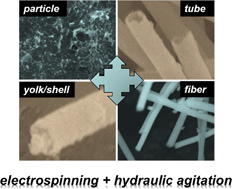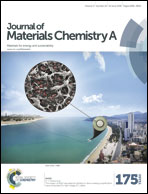Synthesis of one-dimensional NiFe2O4 nanostructures: tunable morphology and high-performance anode materials for Li ion batteries†
Abstract
In this study, various controllable one-dimensional NiFe2O4 nanostructures including solid nanofibers, yolk/shell nanofibers and nanotubes have been successfully synthesized by a novel “electrospinning–hydraulic agitation” combined method. The morphologies, components and structures of different NiFe2O4 samples were characterized by scanning electron microscopy (SEM), transmission electron microscopy (TEM), X-ray diffraction (XRD), N2 adsorption–desorption curve, X-ray photoelectron spectroscopy (XPS), Fourier transform infrared (FT-IR) spectroscopy, thermogravimetric analysis (TGA) and inductively coupled plasma-atomic emission spectrometry (ICP-AES). A possible formation mechanism for the different morphologies was proposed based on the experimental results. More importantly, this method has been verified to be universally applicable for fabricating a variety of ferrite materials with tunable shapes, such as CoFe2O4, ZnFe2O4, CdFe2O4 and α-Fe2O3. Compared with the NiFe2O4 nanoparticles, solid nanofibers and yolk/shell nanofibers, the NiFe2O4 nanotubes exhibited a superior lithium storage capacity, which stabilized at an average capacity of 1349 mA h g−1 even after 220 cycles at a current density of 100 mA g−1. The unique one-dimensional continuous tubular nanostructures and the higher surface area of NiFe2O4 nanotubes deliver a prominent contribution to the excellent electrochemical performance.

- This article is part of the themed collection: JMC A Editor’s choice collection: Recent advances in batteries

 Please wait while we load your content...
Please wait while we load your content...